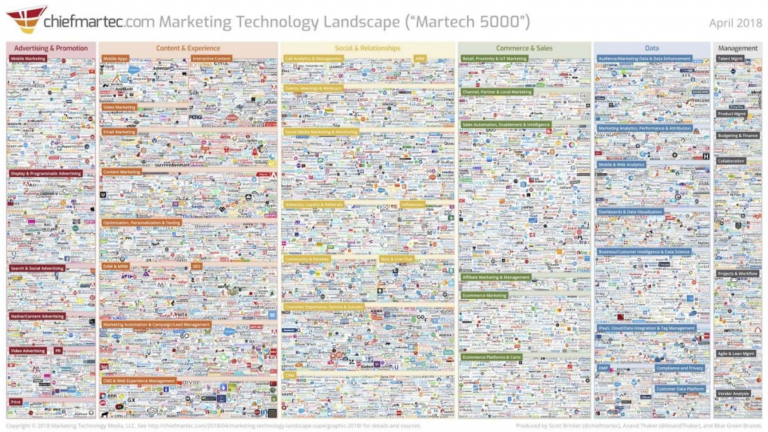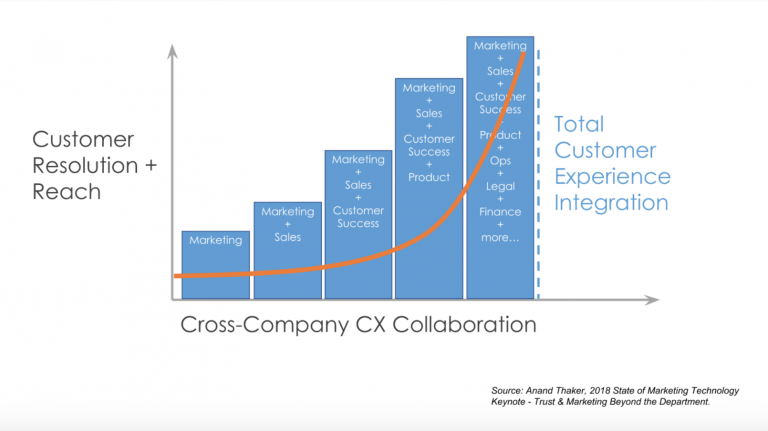Marketing moving beyond the department
Anand Thaker shares key traits of successful marketing teams—insight learned from more than 15 years experience leading the martech industry.
Author: Anand Thaker
Anand Thaker has more than 15 years experience in marketing technology and growth strategy, spanning marketing & sales strategy, operations, data, analytics, investing, and intelligent systems. In this guest post, he looks at the changing role of consumers and the impact of digital transformation, highlighting some of his observations in the common threats and opportunities.
As the digital consumer transforms, so has the marketing department. C-Level executives across industries are adapting to evolving expectations and deploying new experiences to match them.
Customers reward strong brands—large or small—with their advocacy and loyalty. According to IDC, two-thirds of the CEOs of Global 2000 companies have established digital transformation as a core corporate strategy. A Walker study indicates that by the year 2020 customer experience will overtake the importance of both price and product together as a key brand differentiator.
Top brands make their growth and innovation look easy—but what’s behind it? How do they really achieve higher ROI, CLTV, and shareholder value?
Through working with and investing in hundreds of organizations, I’ve found that successful brands have successful marketing teams—and they share these top key traits:
Customer-driven purpose
The premise here is to know thyself first, then make an impact on the world. Harness the sense of purpose of your organization. What problem do you solve for your customers? What makes you different? These core questions set the tone for all the transformation efforts that follow.
Well-aligned go-to-market teams
Success depends on collaboration across marketing, sales, customer success, and product/operations. Transformations usually begin first between marketing and sales, then with the other groups. (A typical exception is high-growth companies in which product leads, so they may start with marketing and product alignment.) Alignment matches customer persona with the complete experience. Traditional segmentation is a common starting point but rapidly evolves.
Effective cross-function
All of sales does not have to work with all of marketing all the time. Sales teams responsible for enterprises should work with marketers who have similar responsibilities. Members of sales, product, marketing, and customer success should collaborate on a ‘first-time homebuyers persona.” Forming these cross-organizational teams have led to new dynamics in an organization’s hierarchy. Breaking down teams this way delivers an aligned customer-focused collaboration.
All about the data
Successful brands think about a digital transformation from a data perspective. Technology implementation becomes about data democratization. As Winning with Data authors Tomasz Tunguz and Frank Bien describe it, “When we say data-driven, we’re talking about companies that operationalize data. We [are] talking about workers who wake up every morning and use data to tune their actions throughout the day.”
Successful marketing leaders recognize their operational role beyond marketing. Robust data analysis skills are invaluable. Operational data awareness reveals company insights into the health of the organization. Knowing the engagement data reveals customer and marketplace insights. The intersection allows marketers to tap into a dynamic story.
With data democratization, there is not only greater transparency but also a better sense of each team’s role. Technology becomes a more straightforward implementation. For marketing technology leaders, access to this visibility is a professional gamechanger.
Attention to signals, reaction with agility
With a strong customer-focused, data-enabled culture, an organization can develop signals and act agilely. Signals provide insights and opportunities. Agility is the capacity to react to them. Signals come from the content and engagement data your brand produces, but also from consumers creating prolific digital footprints associated with your brand—millions of data points rich in signals for those who pay attention to them.
Goals over tasks
The best leadership delivers clarity and purpose to their teams. Rather than assigning tasks, they assign customer or revenue goals and let their team figure it out. Enabling your team to navigate and decide for themselves can generate creative options. They will discover innovative ways to meet customers needs and forecast opportunities.
Recess over classrooms
I’m a huge fan of “play.” Doing has long proven to have a longer lasting impact than watching from the sidelines. Not only should you consider training your team on skills, but interactions with customers and the industry at large. Also, train teams to become better with data judgment and decision-making ability. According to superforecasting expert Philip E. Tetlock, such teams improve the accuracy of forecasting by up to 83%.
‘T-Shaped’ talent
Scott Brinker, from his book Hacking Marketing, says “These [full-stack marketers] are T-shaped people: deep in at least one area but proficient across many.” We need adaptable talent to meet the dynamic nature of customer needs and expectations.
View of technology as a problem—and an answer
I researched the nearly 7,000 vendors for the latest Martech Landscape.

Needless to say, it can be overwhelming. Add to that the dizzying pace of marketing execution for an array of personas and channels, and the challenge increases still.
As go-to-market teams become dedicated to measurement, the technological fragmentation hinders progress. People and technology convert data into signals differently. There are differing dimensions, buckets, and depth. This causes silos, incompleteness, and inconsistency. So instead of making informed decisions, go-to-market leaders rely on what they’ve done or seen other people do. This creates missed opportunities to engage your customers with your unique brand at the right moment.
Technology only magnifies the people, process, and data behind them. When you get these down pat, expect good outcomes and ROI from your technology implementations.
Honing in on the customer
Many successful leaders have their teams begin by focusing on one customer persona. They focus, go deep, connect the experience, and include feedback. They learn as a cross-functional team. They define the right metrics and agree on meaning, cadence of execution, and sentiment among customers. Where I’ve seen teams the most successful is when they develop a strong intuition and accurate projection of campaign outcomes.
Agility comes from a full understanding and empathy, data, and seasoned marketing execution. At this point authority on matters become decentralized. Sounds like chaos? Not so with an excellent team, training, and culture.
Companies like Amazon, Hubspot, Atlassian, Microsoft, Apple, Southwest, and T-Mobile are a few of the many examples where marketing finds their way beyond the department to deliver innovative and improved experiences.

By breaking down silos beyond marketing, we see companies emerge resilient and responsive to opportunities never achievable before. We see their success manifested in community engagement and advocacy. And as a result, we see these companies experience profitability, revenue growth, resilience, and/or increase in shareholder value.
Ref: www.clickz.com

